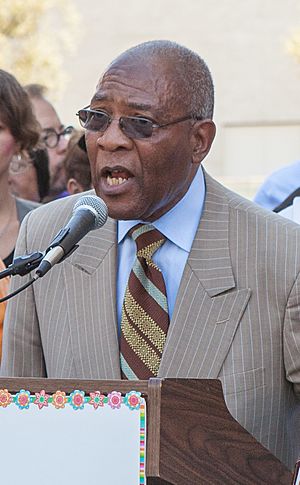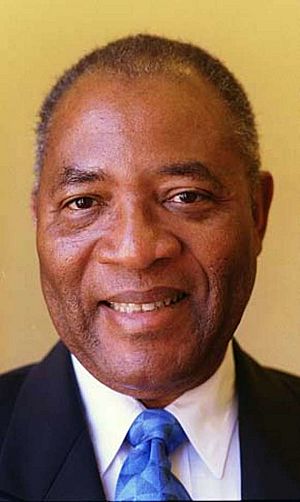Amos Brown facts for kids
Quick facts for kids
Amos C. Brown
|
|
|---|---|
 |
|
| Born |
Amos Cleophilus Brown
February 20, 1941 Jackson, Mississippi, U.S.
|
| Nationality | American |
| Alma mater | Morehouse College (B.A., 1964) Crozer Theological Seminary (M.Div., 1968) United Theological Seminary (D.Min, 1990) |
| Occupation | Pastor • activist |
| Employer | Third Baptist Church of San Francisco |
| Title | Member, San Francisco Board of Supervisors |
| Term | 1996–1999, 1999–2001 |
| Board member of | NAACP |
| Spouse(s) | Jane Smith Brown |
Amos Cleophilus Brown (born February 20, 1941) is a respected African American pastor and a leader in the fight for civil rights. Civil rights are the basic rights that every citizen should have. He is the president of the San Francisco branch of the NAACP, a famous organization that works for the rights of African Americans.
Since 1976, he has been the pastor of the Third Baptist Church in San Francisco. As a young man, Brown was one of only eight students in the only college class ever taught by the famous civil rights leader, Martin Luther King Jr. He also serves on a special team in California working on the issue of reparations.
Contents
Early Life and a Call to Action
Amos Brown was born in Jackson, Mississippi, in 1941. His great-grandfather had been born into slavery. Brown's father was a pastor for churches in the countryside and also worked as a janitor.
From a young age, Brown was involved in activism. In 1955, when he was a teenager, he started the first youth council for the NAACP in his area. He met Martin Luther King Jr. for the first time in 1956 at a national NAACP meeting. The civil rights hero Medgar Evers invited Brown and drove him there himself.
Standing Up to Segregation
In 1959, Brown gave an interview where he spoke out against segregated schools. At that time, Black and white students were forced to go to separate, unequal schools. Because he spoke out, his high school, Jim Hill High School, told him he could not return for his final year.
Medgar Evers stepped in to help. He warned the school that the NAACP would file a lawsuit to allow Black students into the nearby white high school. The school then let Brown back in. However, they got rid of the student council to remove him from his role as president. Even though his classmates elected him senior class president, the school blocked him from taking the position. He also earned the highest grades, but was named salutatorian (second-highest) instead of valedictorian (highest).
Studying with a Hero
Brown went to Morehouse College and graduated in 1964. He then attended Crozer Theological Seminary to study religion. Martin Luther King Jr. himself wrote a letter of recommendation for Brown.
At Crozer, Brown was chosen for a special class on social philosophy, which is the study of how society should work. The class was co-taught by Dr. King. Brown was one of only eight students selected for this unique opportunity. He later earned advanced degrees, including a Doctor of Ministry.
A Career Fighting for Justice
In 1976, Brown became the main pastor at the Third Baptist Church of San Francisco. He has held important roles in the NAACP, including leading its youth division. He is currently the president of the San Francisco NAACP and serves on its national board of directors.
From 1996 to 2001, Brown served on the San Francisco Board of Supervisors, which is like the city council. He was first chosen for the position by Mayor Willie Brown and was later elected by voters. He ran for re-election in 2000 but did not win.
Key Moments in Activism
The Civil Rights Movement
Brown has pointed out that the story of the student sit-in movement is often simplified. Sit-ins were a form of peaceful protest where Black students would sit at "whites-only" lunch counters. Brown said the first organized sit-ins were led by the NAACP Youth Council in Oklahoma City in 1958.
In 1961, Brown was arrested with Martin Luther King Jr. during a sit-in protest. That same year, he joined the Freedom Riders. The Freedom Riders were brave groups of Black and white activists who rode buses together through the South to challenge segregation laws.
Supporting Equal Rights
Brown has been a strong supporter of rights for all people. In 1991, he spoke in favor of a California bill to protect the rights of the LGBT community. In 2012, he and the NAACP National Board voted to support marriage equality.
Working for the Community
Brown believes that reparations, or payments, should be made to Black people. He says this would help fix economic problems and educational disadvantages caused by the long-term effects of slavery.
He has also done a lot of work in Africa. He first visited in 1964 and has been back more than 20 times. His church has helped many African refugees and made it possible for 80 children from Tanzania to get heart surgery in the United States.
In June 2025, Brown announced he was stepping down as head pastor of his church. He said he was "repositioning" himself for new work, not retiring.
Awards and Recognition
- Martin Luther King Jr. Ministerial Award


